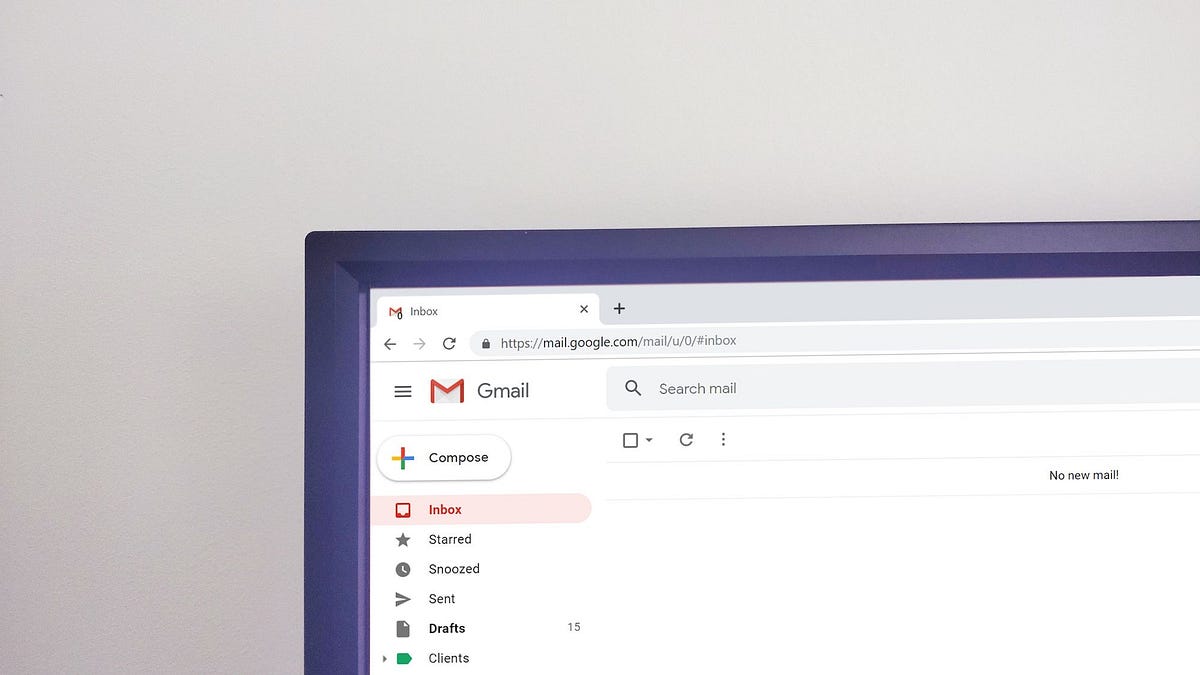When Ray Tomlinson sent the first email in 1971, I wonder if he imagined that 50 percent of Americans would eventually check email while in bed. Or that 42 percent would admit to checking their inbox in the bathroom.
Despite instant messaging apps and evolving communication tools, email isn’t going anywhere. In fact, the average professional still spends 28 percent of their workday reading and replying to emails.
That’s about 2.6 hours — not including those inbox checks while your head is still on the pillow.
Many people loathe email, but I love it. Used well, it can enhance productivity and communication. It can streamline workflows and clarify meaning. A well-composed email also raises the profile of the sender.
Used badly… well, that’s another story. My eyes cross when people write emails like they chat or text; one line after another without any breaks. It’s exhausting — and can lead to errors and misunderstandings.
At my company, Jotform, I often provide detailed feedback to help our 150 employees write more precise emails. My team is probably tired of receiving notes that say “use @ tags!” or “bold the dates,” so here are 12 tips to sharpen your email game — and maybe even boost your career in the process.
1. Use clear, searchable subject lines
The right subject line can determine whether an email is read or deleted. And remember — you don’t have to write it first. Wait until you can clearly summarize the contents of your note. A precise and detailed subject line will also be easily searchable in a mail program.
Before:
“Update”
After:
“Number of active customers using the payment feature — August 2019”
2. Name the intended recipients
Always start the email by addressing a specific person or group. Even if you’re cc-ing others on the email, call out anyone who needs to reply or act on the information.
Before:
“Hello,”
After:
“Hello Brianna,”
“Hello Brianna & Chad,”
“Hello Marketing team,”
3. Don’t bury the lead
Journalists have long used the “inverted pyramid” in news writing, especially for breaking stories that need to quickly convey the five Ws (who, what, when, where, why).
Imagine a triangle pointing downward. The wide part represents the most important information. The triangle then tapers down into minor facts and background details.
Good emails work this way, too. Present critical information before providing a deeper context.
Author and US Navy veteran Kabir Sehgal says military personnel use a technique called Bottom Line Up Front (BLUF). He also shares an example from the Air Force Handbook:
BLUF: Effective 29 Oct 13, all Air Force Doctrine Documents (AFDDs) have been rescinded and replaced by core doctrine volumes and doctrine annexes.
BLUF isn’t the most civilian-friendly term, so Sehgal suggests a more common phrase, like “Bottom Line,” to highlight key facts up top. Then, add any necessary background or context — and label each section.
Before:
“Hello,
I know your teams are getting ready to explore card formats and they’re doing some great work. Creative juices are flowing. I think we should consider having a hack week in the next couple months to kick-start the process. Aytekin has signed off on this, so I am going to schedule it for the first week in October.”
After:
“Hello Product Team Leaders,
Bottom Line: All product teams will participate in a Hack Week from October 1–5, 2019.
Background:
– This is an effort to amplify the creative work that product teams have already begun
– Aytekin has approved the hack week, so please add these dates to your team calendars”
4. Provide specific dates and times
Vague timelines like “tomorrow” and “next week” have a short shelf life. Instead of making recipients check the dates or, if they’re reading an old message, trying to calculate when “yesterday” was, use exact dates and times.
Before:
“Omer told me that the support team had answered all outstanding tickets by late yesterday afternoon. This should help with next week’s launch.”
After:
“According to Omer, the support team had answered all outstanding tickets by 4 pm yesterday, August 6, 2019. This will ease support flow during the transcription feature release next Wednesday, August 14, 2019.”
5. Highlight and specify your requests
Our eyes can easily pick out our own names on the screen. Use this to your advantage and @ tag anyone in a group thread who needs to take action. Highlight or bold your request and make your request as specific as possible.
Also, put the request in a separate paragraph so it stands out and is easily scannable.
Before:
“Hello,
We’ve updated the Mobile Forms page. Please review and provide your feedback around design, copy, and illustration placements. We also need to shorten the FAQs.”
After:
“Hello Liam, Omer & Allie,
The revamped Mobile Forms page needs your attention. Please review the staging site.
@liam: ensure it meets design standards
@omer: edit feature sections and trim at least 100 words from each FAQ entry
@allie: sign off on illustrations and layout placement
6. Write in your natural voice
Many people write more formally than they speak. Blame all those high school term papers and essays, but in the business world, the best emails are simple, not jammed with adjectives and unnecessary words. Try to write emails that sound like you — only more concise.
Before:
“Hello Aytekin and Marketing Team,
This email is written to inform your team about what our team has been collaboratively working on and how that work shapes our priorities moving forward.”
After:
“Hello Aytekin and Marketing Team,
I want to share what the Payments Team has been working on.”
7. Stay active, not passive
Active voice writing is clear and straightforward. It eliminates ambiguity by placing nouns before verbs — and it’s more compelling to read. As the Air Force manual explains,
“Besides lengthening and twisting sentences, passive verbs often muddy them.”
Passive: The lazy dog was jumped over by a fox that was brown.
Active: The quick brown fox jumps over the lazy dog.
8. Format for clarity
If you have to write an email longer than 1–2 paragraphs, avoid huge text blocks. Use headlines, bullets, and numbers. Make sure the text is scannable. Highlight any sections that demand special attention, or use colors to indicate new headings or topics.
Before:
“Hello Aytekin & Marketing Team,
The Payments Team has been busy working on several different projects. We finished the Stripe 3DS 2.0 implementations for Sell Product, User Defined Amount, and Donation type payment forms. We also opened Stripe 3D Secure to 10 Jotform users for testing and are following these users now, before we open it to others. Charge Later is almost done, but we’ll continue to make some improvements. I think we’ll have everything done in about two weeks.”
After:
“Hello Aytekin & Marketing Team,
I want to share what the Payments Team has been working on.
Completed:
– Stripe 3DS 2.0 implementations were finished for Sell Product, User Defined Amount, and Donation type payment forms.
– We opened Stripe 3D Secure to 10 Jotform users for testing. We are following these users now. After that we will open to others.
Outstanding:
– Charge Later: It’s almost done, but we will make some improvements here.
Implementation timeline:
We expect to complete these changes in 2 weeks.”
9. Include images whenever possible
Screenshots, photos, and drawings can replace hundreds of words. Tables and spreadsheets can be helpful, too. Always include an image in your email if it’s relevant and allows you to cut down on the text.
Before:
BI Team,
Can you find out why active users dropped in January?
After:
BI Team,
Can you find out why active users dropped in January?
10. Squeeze out excess words
Many of us clarify our thoughts through writing. By the time we’ve drafted an email, we know what we actually want to say. That’s where editing comes in. You wouldn’t send a report, write marketing copy, or release press materials without editing. Emails should be edited, too.
Practice making your emails as short as possible (without sounding like a robot). Draft your email, try to cut the text in half, then trim even more. This process will drastically improve your emails — and your writing overall.
Before:
“We’ve begun to realize, based on customer feedback, that there are a number of bugs in the offline data collection process, and these should all be addressed immediately, without hesitation. The Assign Forms feature was also flagged by internal stakeholders as an area that should be explored with deeper User Experience testing processes.”
(56 words)
After:
“There are several we need to address immediately:
– Customer-reported bugs in offline data collection
– Assign Forms requires further UX testing”
(25 words)
11. Remember that email isn’t chat
Chat, IM, texts, and Slack serve do not serve the same purpose as email. For example, you might text a friend to say “At café. Scored corner booth. See U soon,” but you wouldn’t send a similar email — especially in a professional context. Try not to slip into text and chat habits when you’re writing emails.
Before:
Many of our younger employees
Write sentences stacked on sentences
like they’re using Slack or Messenger
It’s confusing and difficult to read
And it goes against online etiquette
Unless you’re writing a poem
After:
Many of our younger employees write sentences stacked on sentences, like they’re using Slack or Messenger.
It’s confusing and difficult to read. And it goes against online etiquette — unless you’re writing a poem.
12. Don’t send when you’re stressed
Or angry. Or confused and emotional. You can write an email that expresses all those feelings, but save it as a draft until your head clears. It’s far too easy to dash off a note and hit “send” before you’ve truly thought it over. You might see the situation differently a few hours (or days) later.
I also recommend leaving the recipient’s name off the email when you’re drafting a difficult message. And if you’re not sure whether you should send a note, share it with a trusted friend or colleague who can offer some outside perspective.
Happy emailing!

















Send Comment:
1 Comments:
More than a year ago
The best essay writing service will not only deliver a high-quality paper within a deadline, but it will also keep your academic reputation on track. This service offers custom writing to meet your individual specifications, and you can choose what features you need and add extras. Essay writing services can be found online and they will deliver the paper to you before the deadline. However, be aware that many schools have academic integrity rules and codes of conduct. Consequently, it's not a good idea to submit other people's work in your name.